Gameboard Legend
A INCOME P&L
Income is generally the top portion of the Income Statement which is also referred to as the Profit & Loss Statement, P&L or P&L Statement. Income includes all funds flowing into the entity for any reason. Income could be earned income, refund expenses, one-time income, recurring income, or other income. Income may also be referred to using the term “revenue.” At times and for accounting reasons, income may be shown as a negative number. An example of negative income may be a refund to a customer.
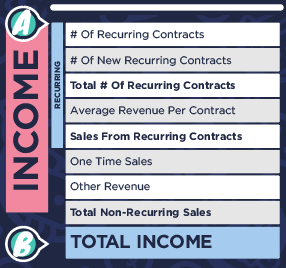
B TOTAL INCOME P&L
Total Income is the sum (total or all income added together) of all income. This total is derived by adding up all of the income.
C EXPENSES P&L
Expenses represent outflows of cash or assets to the company. Expenses are separated into Transactional and Operations. Expenses could be the cost of goods used to make a product, labor, insurance, taxes, equipment or other fees paid out. For the game, calculate the expenses as a percentage of the income for the same month.

D TOTAL EXPENSE P&L
Total Expenses is the sum (total or all expenses added together) of all expenses. The Total Expense value is derived by adding up all of the expenses.
E THE BOTTOM LINE P&L
The Bottom Line is derived by subtracting the total expenses from the total income. The goal of business is to have a positive Bottom Line meaning the company made more money than it spent. A positive Bottom Line is also called “being in the black” versus a negative Bottom Line is referred to as “being in the red.”
F REGION P&L
The region is going to be an assigned city. Vehicle payment amount is equal to your monthly vehicle payment which is determined at the start of the game using the Regional Assignment Sheet (see “LOANS”). Revenue per contact is based on the economic health of your region which changes throughout the game. These values are determined before beginning play. See Instructions on setting up the game.
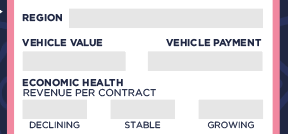
G TURNS P&L
Basic instructions on the turns of the game. Refer to the detailed instructions for more about each step.
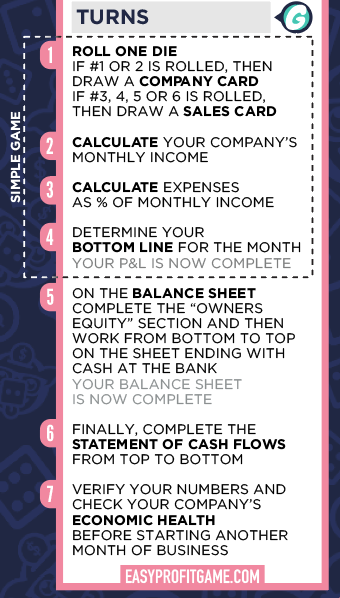
H ASSETS Balance Sheet
Assets are a listing of the cash, inventory, land or buildings a company owns. To determine the Cash at the bank, add the cash from last month to the Bottom Line from the previous month. Other events such as loans or equity contributions can also affect the calculation for cash at the bank (see “Loan” section for more details). Inventory is determined by the inventory from the previous month and any of the same that was made or acquired in the current month. Equipment, Real Estate or other long-term assets is determined by the value from the previous month and any of the same acquired in the current month. Vehicles asset values are entered when they are acquired at full purchase price and are depreciated each month equal to the value of the payment. For the purposes of the game, the owner has donated inventory and equipment which is also reflected in the owners equity.
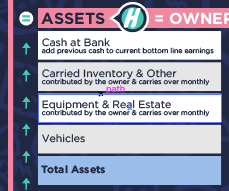
I LIABILITIES Balance Sheet
Liabilities are a listing of the amounts owed to others. Loans are derived based on loans the company takes. Loans are all decreased in the amount equal to the payments without consideration for interest.

J OWNERS EQUITY Balance Sheet
The Owners Equity is a real time representation of the value the owner has in the company. Although it is commonly referred to using a percentage, on the Balance Sheet, it is a real number. The Capital is steady from one month to the next unless additional capital is paid by the owner or if the owner is paid a portion of their capital. Revenue is equal to the Total Income. Expenses are equal to the Total Expenses.
RETAINED EARNINGS are a sum of the following items: Revenue, Expenses & Retained Earnings from the previous month.
K TOTAL OWNERS EQUITY Balance Sheet
To ensure the Balance Sheet is actually in balance, one can always add the Liabilities to the Owners Equity and that should equal the Assets. This indicates the Balance Sheet is in balance.
L OPERATING ACTIVITIES Statement of Cash Flows
Values for the Operating Activities are pulled from the main P&L Board and are a summary of the income and expenses related to operations.
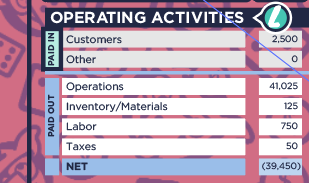
M INVESTMENT ACTIVITIES Statement of Cash Flows
Values for the Investment Activities are pulled from the main P&L Board and are a summary of the income and expenses related to investments into the company such as purchasing or selling equipment. For the purposes of the game, the trigger for changes in these values will happen as a result of Sales or Company Cards. And, these features are limited to the advanced versions of the game so the values for Investment Activities will remain zero for most game plays.
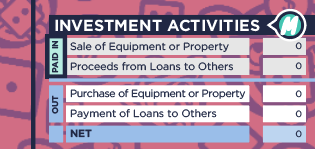
N FINANCIAL ACTIVITIES Statement of Cash Flows
Values for the Operating Activities are pulled from the main P&L Board and are a summary of the income and expenses related to business capital or owners equity. For the purposes of the game, the trigger for changes in these values will happen as a result of Company Cards.
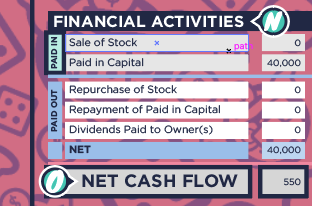
O NET CASH FLOW Statement of Cash Flows
Net Cash Flow is the result of each of the three financial activities sections for the month. The result shows if the company had a positive or negative cash flow for the month. Viewing the monthly values over time can show trends or annual cycles.
